What is design thinkingWhat is Design Thinking?
What is design thinking ?
Page Summary
In the rapidly changing business environment of the 21st century, strategic innovation is essential to organizational success.
In this age, leading companies around the world, including Japanese companies, are using design thinking as a methodology to specifically create new customer value.
This page provides a brief introduction to what design thinking is, the kind of effects it has, and what to be aware of during its implementation.
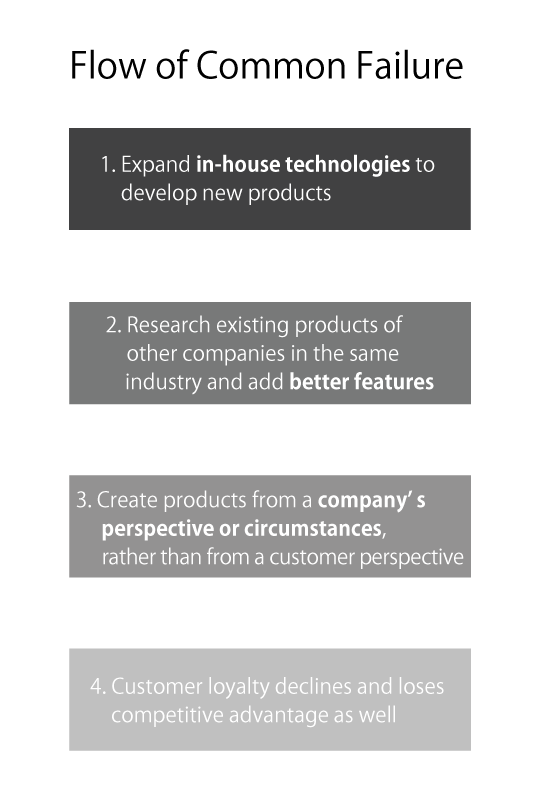
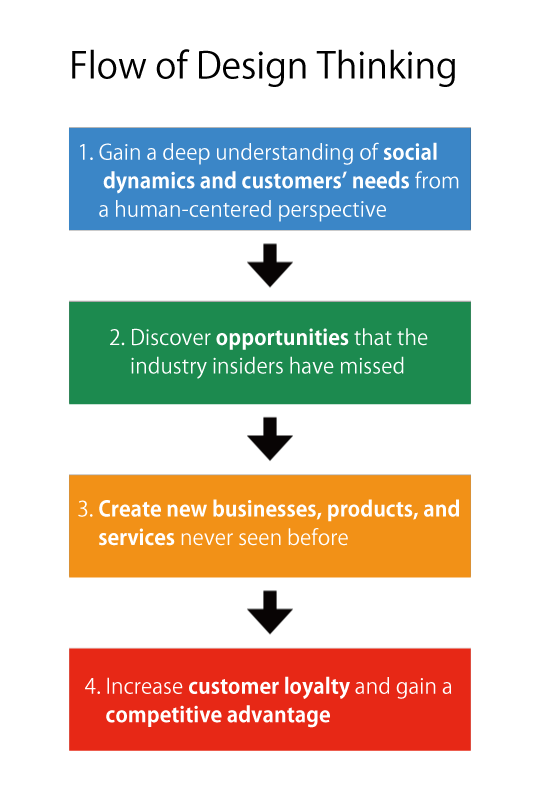
Overview of design thinking
Design thinking is a methodology for innovations. Based on a deep understanding of customer behaviors and the social situation, it not only logically analyzes digitalized data, but also provide new value to the world through the process of intuitively creating the future of society and business visions.
Design thinking stresses on human-centered perspectives. Human-centered means that we should always create value from customer or society perspectives. Conversely, we should not think about businesses based solely on a company’s financial constraints or the technical constraints of a product. Design thinking is a methodology that realizes human-centered innovations and discovers and solves problems.
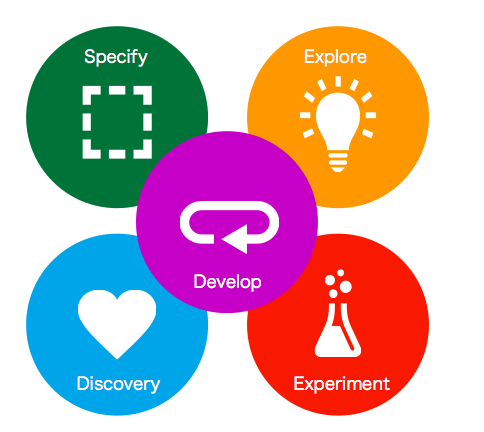
Design thinking can be split into two main components: the problem discovery stage, which is used to understand the current customers and social dynamics, and the problem-solving stage, which is used to create an ideal business concept beneficial to customers and society. More specifically, it can be broken down into the following four procedures:
- reveal customers’ and society problems via on-site investigation,
- redefine the problems from a perspective different from before,
- search for a large volume of solutions while prioritizing quantity over quality,
- and create high-quality concepts through interaction with customers.
Design thinking is different from a linear approach in which errors noticed during the process remain uncorrected. Design thinking premises on repeating necessary procedure multiple times, depending on the situation. Design thinking works with the discovery and resolution of problems through trial and error from a customer, industry, society, and other perspectives and aspects, and encourages the creation of a new conclusion different from the past.
Effects, importance, and examples of design thinking

The movement to incorporate design thinking into businesses is spreading not only in Japan but also in the United States, Germany, China, and many other countries. The Harvard Business Review, seen by 600,000 leading businesses and professionals in 14 countries around the world, also features design thinking—an example of its importance.
So, what kind of effects do design thinking provide? Why is it so important to incorporate design thinking into businesses? The following is a simple introduction to some of the research and investigation on how design thinking is related to businesses.
Leading companies such as Apple, Coca-Cola, IBM, Nike, and P&G, which use design thinking to develop their businesses, have recorded more than two times the growth (211%) than other S&P 500 companies in 10 years.
A survey with 339 decision makers in the United States, the United Kingdom, France, Germany, South Korea, Australia, New Zealand, and Japan found that the strategic use of design thinking had increased customer loyalty (50%) and was also effective in building competitive advantage (46%).
Let us take a look at an actual example. Apple has been aware of what its customers are looking for since its establishment, and it did not develop products that were premised by its technical constraints. A macOS designer in the 1990s said the following.
We started with the design. We focused on what people need, what they want, and how they interact with computers.
And after confirming that we had a good understanding of the people’s needs, we thought about how to implement them technically. In most cases, people do not know how to assemble an actual useful design even if they have come up with it.
Firstly, we had a design goal, and we worked with the engineering team to actualize it. In the end, we were able to accomplish many tasks we thought were impossible or would take a long time to complete, by Cordell Ratzlaff, Apple.
As the example above shows, this method of which technical challenges are tackled after what people want and need have been identified is called human-centered design—it is a fundamental mindset in design thinking.
Relying on human-centered ideas, we do not think about businesses based on technological and financial constraints of a company, but instead, create new value—innovation—that begins with the needs of the customers and society.
Source:DMI, Adobe, Harvard Business School
What specific procedures are required in order to incorporate design thinking into corporate activities? The following is the d.seed model that visualizes design thinking into five phases.
1. Discover phase

What is Discover ?
In this phase, you put aside the idea of classifying customers by general properties such as age, occupation, annual income, and address. Instead of interacting with customers before knowing them and after they were categorized, you should understand them by deeply empathizing with the kind of person they are and the background stories that surround them.
Importance of the Discover phase
While resources such as organizational technology and funds are also important in driving innovation, products and services created through using of resources can spread throughout the world because of the customer support they have received. To win customer support, you must create new value for the customers.
2. Specify phase
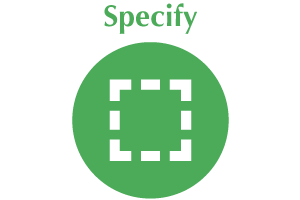
What is Specify ?
In the Specify phase, you organize and analyze the customers and information about their behaviors obtained in the Discover phase, and obtain insights that lead to customer needs and innovation opportunities.
Importance of the Specify phase
During the Specify phase, as you carefully review and check the customers’ information, you can obtain a new perspective that your team or organization had not anticipated. This new perspective will lead to the next innovation.
3. Explore phase

What is Explore ?
In the Explore phase, candidates of new concepts that can create values are identified through an investigation. As the name Explore suggests, it is important to expand the potential of new businesses, products, and services, rather than invent a single perfect answer. Through this phase, you can acquire the opportunity to create innovative solutions for customers and society.
Importance of the Explore phase
Very rarely would you encounter only a single method to meet a customer’s needs. Once you have narrowed down the issues and problems that customers possess, you create as many methods as possible that can solve them. It is important to come up with as many options as possible during the Explore phase, especially so when the project or business development process is in the early stages.
4. Experiment phase

What is Experiment ?
In the Experiment phase, you acquire customer feedback by materializing ideas. The goal is to experimentally demonstrate how are the ideas you have envisioned valuable to the customers.
Importance of the Experiment phase
Through the Experiment phase, you can determine which part of the created idea to focus on when progressing with the project development, and use customers’ feedback to help shape the process. An important part of the Experiment phase is to learn something new the team has not noticed before.
5. Develop phase

What is Develop ?
Once the utility of a new concept has become more apparent than before, the process of commercializing this new concept can be driven with the help of internal parties involved, who are not part of the team, as well as external partners. Specifically, you will expand the business operation in two directions to enhance business feasibility.
Importance of the Develop phase
By carrying out the Develop phase, stakeholders such as team members, internal parties involved, and external partners can create opportunities that provide themselves the support they need for future business development.
Four key points in incorporating design thinking
There are several principles to effectively incorporate design thinking into an organization. We narrowed them down to four especially important key points.
1. Taking baby steps
Not just limited to design thinking, new initiatives rarely spread throughout a company overnight. No matter the methodology, you need to spend time getting people to understand why a specific method is important and how to go about executing it.
The most important point in design thinking is a human-centered mindset. As introduced in the brief example with Apple, if you want to create a new market through innovation, this mindset is essential.
No matter your position, most organizations do not welcome proposals that incite rapid changes. Instead of attempting to change everything all of a sudden, try starting with small steps—baby steps. For example, you can form an informal team of two or three members and start working on design thinking. Set aside some time every week to work on improving knowledge and skills and try to apply just a little bit of design thinking into the business process as if it were an experiment.
2. Creating teams: administration, management, and frontline employees
Effective use of design thinking requires the collaboration of the administration level, the management level, and the frontline. For example, if you are in an administrative or management position, you can engage directly or indirectly in design thinking.
Direct engagement includes launching your own projects and actively removing organizational barriers that hinder the realization of innovative ideas.
On the other hand, indirect engagement is the provision of various support as necessary so that your subordinates can implement projects smoothly. Several examples are introducing existing customers to be surveyed, providing feedback on concepts, and securing new budgets.
3. Integrate design thinking into existing product development and strategy creation processes
Once you have built up some track record through taking baby steps, you need to converge design thinking and the main processes of your organization together. Specifically, you need to incorporate design thinking into existing product development and strategy creation processes.
For example, if the product development process starts with the functional analysis of an existing product, you will delay the analysis a little and start with a qualitative customer survey. Or, if strategy creation starts with a business analysis of a competitor, you will begin with understanding the social dynamics (population structure, social conventions, political and economic trends, etc.) that surround the industry.
By strategically integrating design thinking into innovation activities, you can measure how new methods alter the quality and customer satisfaction, relative to existing products and services.
Data gets accumulated through continuous design thinking practices, and it becomes clear that you can expect results unachievable by conventional efforts. In such situations, you will be able to gain support from both internal and external stakeholders that design thinking is not an option for business creation, but an essential prerequisite.
4. Focus on learning and not short-term achievements
Design thinking is nothing more than a trigger that promotes innovation. Please do not expect immediate results in the early stages. In the early stages, it is important to commit to learning, not to results.
This is because in order to achieve exceptional results with a new product or service, it is necessary to have a deep understanding of the customers’ behaviors, feelings, environments that surround them, etc., before developing the product or service.
You can start learning from any specific range. For example, if there is a function that is not being used as often as expected, you can set it your learning goal to understand why customers do not use this additional feature. Then, keeping in mind your learning goal, interact with customers to learn what you did not know before. As a result, you may discover that customers did not realize there were additional features in the first place, or the operation was so complicated that they gave up using it halfway through.
Even if the current project failed in the end, the new customer information obtained during the process will serve as an important resource for the next project to produce results. Firstly, try proceeding with the project with a goal to learn.
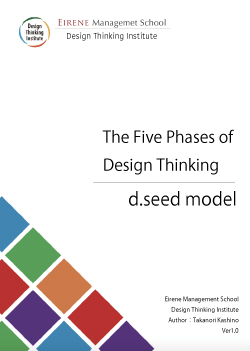
Design thinking, a methodology for innovation. The d.seed model, which visualizes the process of design thinking, consists of five phases. This textbook describes the characteristics of design thinking and the contents of the d.seed model. This book is recommended for those who plan to learn design thinking, as well as those who have already learned design thinking. You can download it for free, so please use this opportunity to take a look at it.
《The Five Phases of Design Thinking:d.seed model》
No registration required:You can free download following the button.
